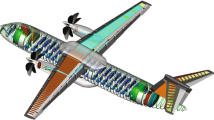Abstract
Simulation results of the longitudinal motion of a civil twin-engine aircraft with an active high-lift system are presented. The investigated system uses the lift-increasing effect of blowing over Coandă flaps along the wing. The core elements of the nonlinear model describing the dynamic behavior of an aircraft with this specific type of active high-lift system are explained. The main focus lies on the analysis of the aircraft’s reaction to an instant symmetric total failure of such a system. Initial investigations analyze the outcome of such failures, if throttle is set to maximum and elevator is controlled, without using stabilizer or flaps. Subsequently, an investigation has been performed estimating the effect of flap reconfigurations and stabilizer adjustments. The paper also considers a temporary failure of the system due to an engine failure combined with a too low power setting of the remaining engine which has to be increased first before the restart of the blowing system. The investigated situations vary from inconvenient to unrecoverable. Recommendations for backup systems and procedure changes are made to prevent such situations. A procedural approach is analyzed and respective simulations prove the efficiency of this solution.













Similar content being viewed by others
Notes
Created by Tayson Weiss, Institute of Aircraft Design and Lightweight Structures (IFL), TU Braunschweig.
Release 2007b, by MathWorks®.
Abbreviations
- \(C\) :
-
Coefficient or derivative
- \(C_{\rm \mu }\) :
-
Jet momentum coefficient
- \(\Delta C_{\rm \mu }\) :
-
Deviation from reference jet momentum
- \(C_{\rm \mu \rm Ref}\) :
-
Reference jet momentum coefficient
- \(F\) :
-
Force N
- \(f\) :
-
Factor
- \(H, \Delta H\) :
-
Altitude, Altitude loss m
- \(\dot{H}\) :
-
Vertical speed m/s
- \(I\) :
-
Moment of inertia kgm2
- \(i_{\rm HTP}\) :
-
Incidence angle of horizontal tailplane °
- \(k_{1},k_{2}\) :
-
Drag polynomial factors
- \(l_{\rm \mu }\) :
-
Mean aerodynamic chord m
- \(l_{\rm Ref}\) :
-
Lever arm of horizontal tailplane m
- \(M\) :
-
Mach number
- \(m, \dot{m}\) :
-
Mass, mass flow kg, kg/s
- \(n_z\) :
-
Vertical load factor
- \(p, q, r\) :
-
Angular rates °/s
- \(q_{\infty }, \bar{q}\) :
-
Dynamic pressure N/m2
- \(q^\star\) :
-
Dimensionless pitch rate
- \(S\) :
-
Main wing area m2
- \(S_{\rm HTP}\) :
-
Horizontal tailplane area m2
- \(t\) :
-
Time s
- \(u, v, w\) :
-
Aircraft velocity vector components m/s
- \(V\) :
-
Airspeed m/s
- \(v_{jet}\) :
-
Fluid velocity m/s
- \(\alpha\) :
-
Angle of attack \(^\circ\)
- \(\alpha _{\rm HTP}\) :
-
Local angle of attack at horizontal tailplane \(^\circ\)
- \(\beta\) :
-
Sideslip angle \(^\circ\)
- \(\delta _{\rm Fl}\) :
-
Flap deflection \(^\circ\)
- \(\dot{\delta }\) :
-
Deflection rate \(^\circ\)/s
- \(\varepsilon\) :
-
Downwash angle \(^\circ\)
- \(\eta\) :
-
Elevator deflection \(^\circ\)
- \(\eta _{Prop}\) :
-
Propeller efficiency %
- \(\gamma\) :
-
Fligh path angle \(^\circ\)
- \(\Phi ,\Theta ,\Psi\) :
-
Aircraft attitude angles \(^\circ\)
- \(\tau\) :
-
Transport delay s
- \(\omega\) :
-
Angular frequency rad/s
- \({0}\) :
-
Value for zero angle of attack
- \({A}\) :
-
Aerodynamic
- \({cg}\) :
-
Center of gravity
- \({\rm Cl}\) :
-
Clean Configuration
- \({C_{\rm \mu }}\) :
-
Gradient w.r.t. jet momentum coefficient
- \({D}\) :
-
Drag
- \({\rm dyn}\) :
-
Dynamic value due to angular rates
- \({eng}\) :
-
Engine
- \({delay}\) :
-
Time delay between failure and reaction
- \({fail}\) :
-
System failure
- \({\rm Fl}\) :
-
Flap
- \({G}\) :
-
Gravity
- \({jet}\) :
-
Jet of the blowing system
- \({K}\) :
-
w.r.t. to ground
- \({L}\) :
-
Lift
- \({lim}\) :
-
Limit value
- \({m}\) :
-
Pitching moment
- \({min}\) :
-
Minimum
- \({N}\) :
-
Neutral point
- \({react}\) :
-
Reaction delay
- \({recog}\) :
-
Recognition delay
- \({recover}\) :
-
Recovery setting
- \({\rm Ref}\) :
-
Reference
- \({Stab}\) :
-
Stabilizer coefficient
- \({\rm Stall}\) :
-
Stall
- \({TAS}\) :
-
True airspeed
- \({trim}\) :
-
Trimmed value
- \({\alpha }\) :
-
Gradient w.r.t. angle of attack
- \({\eta }\) :
-
Gradient w.r.t. elevator deflection
- AHLS:
-
Active high-lift system
- AoA:
-
Angle of attack
- BLC:
-
Boundary layer control
- CC:
-
Circulation control
- CFD:
-
Computational fluid dynamics
- CN:
-
Clean-nose
- CS-25:
-
Certification specification 25
- DN:
-
Droop-nose
- EASA:
-
European aviation safety agency
- FAA:
-
Federal aviation administration
- HTP:
-
Horizontal tailplane
- MAC:
-
Mean aerodynamic chord
- OEI:
-
One engine inoperative
- PrADO:
-
Preliminary aircraft design and optimization [tool]
- RANS:
-
Reynolds-averaged Navier-stokes [equations]
- SFB:
-
Sonderforschungsbereich (Collaborative Research Center)
- STOL:
-
Short takeoff and landing
- WFC:
-
Wing/fuselage combination
References
Eurocontrol-STATFOR.: Challenges of Growth 2013, Task 4: European Air Traffic in 2035 (2013). http://www.eurocontrol.int/articles/forecasts
SFB 880: Fundamentals of High-Lift for Future Civil Aircraft (Collaborative Research Center) (2011). https://sfb880.tu-braunschweig.de/
Flatt, J.: The History of Boundary Layer Control Research in the United States of America. In: Lachmann GV., (ed) Boundary Layer and Flow Control, Pergamon Press Ltd., New York 1961
Norton, B.: STOL progenitors: the technology path to a large STOL transport and the C-17A. american institute of aeronautics and astronautics, Reston, VA, USA (2002)
Wimpress, J., Newberry, C.: The YC-14 STOL prototype: its design, development, and flight test American Institute of Aeronautics and Astronautics. 1998
Spitzer, R.E., May F.W.: III. Engine out control system for STOL aircraft. US. Patent. 4(106), 730 (1978).
May, F., Widdison, C.: STOL high-lift design study volume 1. state-of-the-art review of STOL aerodynamic technology. Tech. Rep. AFFDL-TR-71-26-Vol. 1, The Boeing Company, Air Force Flight Dynamics Laboratory, Air Force Systems Command, Wright-Patterson Air Force Base, Ohio (1971).
Werner-Westphal, C., Heinze, W., Horst, P.: Multidisciplinary integrated preliminary design applied to future green aircraft configurations. in 45th AIAA Aerospace Sciences Meeting and Exhibit (American Institute of Aeronautics and Astronautics) (2007). doi:10.2514/6.2007-655
Keller, D.: Numerical investigation of the longitudinal static stability of a transport aircraft with circulation control. In: Proceedings of the 18th DGLR-STAB Symposium. Stuttgart, Germany (2012)
Diekmann, J.H., Hahn, K.-U.: Nonlinear Flight Dynamics Simulation Model for a Civil Aircraft with Active High-Lift System. In: Radespiel, R., Semaan, R. (eds.) SFB 880 - Fundamentals of high-lift for future commercial aircraft, Biennial report, pp. 159–172. Braunschweig, TU Braunschweig - Campus Forschungsflughafen (2013)
Diekmann, J.H., Investigation of flight dynamics of a civil aircraft with active high-lift system. In: Proceedings of the 61st Deutscher Luft- und Raumfahrtkongress. Berlin, Germany (2012)
Radespiel, R., Pfingsten, K.C., Jensch, C.: Flow analysis of augmented high-lift systems. In: Hermann Schlichting-100 Years, Notes on Numerical Fluid Mechanics and Multidisciplinary Design, vol. 102, pp. 168–189. Springer (2009)
Pfingsten, K.C., Radespiel, R.: Numerical simulation of a wing with a gapless high-lift system using circulation control in New Results in Numerical and Experimental Fluid Mechanics, vol. 6, pp. 71–79. Springer (2008),
Gerhold, T.: Overview of the Hybrid RANS Code TAU. In: Kroll, N., Fassbender, J. (eds.) MEGAFLOW - Numerical Flow Simulation for Aircraft Design, Notes on Numerical Fluid Mechanics and Multidisciplinary Design, vol. 89, pp. 81–92. Springer, Germany (2005)
Englar, R.J., Development of pneumatic aerodynamic devices to improve the performance, economics, and safety of heavy vehicles. Tech. Rep. SAE/TPS-2000-01-2208, Georgia Tech Research Institute, Atlanta, USA (2000)
Diekmann, J.H., Trim analysis of nonlinear flight dynamics for a civil aircraft with active high-lift system. In: Proceedings of the 62nd Deutscher Luft- und Raumfahrtkongress. Stuttgart, Germany (2013)
EASA, Certification Specification and Acceptable Means of Compliance for Large Aeroplanes CS-25. Tech. Rep. Amendment 13, European Aviation Safety Agency (2013)
Poisson-Quinton, P., Lepage, L.: Survey of French research on the control of Boundary Layer and Circulation. In: Lachmann GV (ed) Boundary layer and flow control. Pergamon Press Ltd., New York (1961)
Burnazzi, M., Radespiel, R., Design of a droopnose configuration for a Coanda active flap application. In: Aerospace Sciences Meeting (American Institute of Aeronautics and Astronautics, 2013). doi:10.2514/6.2013-487
Keller, D., Rudnik, R.: Aerodynamic Aspects of the Longitudinal Motion of a High-Lift Aircraft Configuration with Circulation Control. In: R.R. and Richard Semaan (ed) SFB 880 - Fundamentals of high-lift for future commercial aircraft, Biennial Report, pp. 147–158. TU Braunschweig - Campus Forschungsflughafen, Braunschweig (2013)
Acknowledgments
Financial support has been provided by the German Research Foundation (Deutsche Forschungsgemeinschaft—DFG) in the framework of the Sonderforschungsbereich 880. This work has been supported by the provison of particular CFD results created with VSAero by Tayson Weiss. Institute of Aircraft Design and Lightweight Structures (IFL), TU Braunschweig. for the clean wing/fuselage configuration and horizontal tailplane as well as DLR’s Tau code by Dennis Keller. Institute of Aerodynamics and Flow Technology (AS), German Aerospace Center (DLR). and Marco Burnazzi. Institute of Fluid Mechanics (ISM), TU Braunschweig. for the full-flap configuration of the wing/fuselage combination with active high-lift system and wing leading edge devices. The reference aircraft design has been developed by Wolfgang Heinze with PrADO.
Author information
Authors and Affiliations
Corresponding author
Rights and permissions
About this article
Cite this article
Diekmann, J.H., Hahn, KU. Effect of an active high-lift system failure during landing approaches. CEAS Aeronaut J 6, 181–196 (2015). https://doi.org/10.1007/s13272-014-0139-7
Received:
Revised:
Accepted:
Published:
Issue Date:
DOI: https://doi.org/10.1007/s13272-014-0139-7




